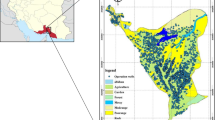Abstract
Impacted by groundwater, faults, lithology, and other factors, the slope of the Shengli no. 1 open-pit coalmine has been in a state of instability. Among these factors, groundwater in the quaternary aquifer is considered primary. Thus, an optimum design for dewatering well pumping rates is presented in this paper. A two-dimensional groundwater simulation model is built to characterize the groundwater flow of the study area. A steady-state model was applied to the observed data (head and discharge) to verify and calibrate the groundwater model. The pilot point method, with a regularization option provided by parameter estimation, was used to identify the hydraulic conductivity field. Afterward, a groundwater optimization model is integrated with the calibrated simulation model to realize groundwater dewatering optimization in the studied open-pit coalmine, and an optimization method called modified Pareto dominance-based real-coded genetic algorithm is adopted. Taking into account the safety of the mine, slope and dewatering wells, seepage discharge is added to objective function and the maximum aquifer saturated thickness is set as the constraint condition in the optimization model. The results indicate that the dewatering optimization procedure developed in this paper can serve as a useful template and framework for solving mining related water problems.








Similar content being viewed by others
References
Aguado EA, Remson I, Pikul MF, Thomas WA (1974) Optimal pumping for aquifer dewatering. J hydraul div 100(7):869–877
Ahlfeld DP, Mulvey JM, Pinder GF (1988) Contaminated groundwater remediation design using simulation, optimization, and sensitivity theory. 2. Analysis of a field site. Water Resour Res 25(5):443–452
Ayvaz MT, Karahan H (2008) A simulation/optimization model for the identification of unknown groundwater well locations and pumping rates. J Hydrol 357(1–2):76–92
Baur P (1998) Water and the mining industry. Water Wastewater Int 13(5):138–140
Bejranonda W, Koch M, Koontanakulvong S (2011) Surface water and groundwater dynamic interaction models as guiding tools for optimal conjunctive water use policies in the central plain of Thailand. Environ Earth Sci. doi: 10.1007/s12665-011-1007-y
Bhattacharjya RK, Datta B (2009) ANN-GA-Based model for multiple objective management of coastal aquifers. J Water Resour Plan Manag-ASCE 135(5):314–322
Cai X, Rosegrant MW, Ringler C (2003) Physical and economic efficiency of water use in the river basin: implications for efficient water management. Water Resour Res 39(1):1013–1024
Cai Q, Shu Q, Zhu G (2008) Research report on landslide control technique of Shengli open-pit coalmine. China University of Mining and Technology, Xilinhot (in Chinese)
Chen Q, Zhang M, Feng X (2000) On the problem of inflow and outflow of fluid in porous media. Eng Mech 17(6):53–58 (in Chinese)
Cheng A-H-D, Halhal D, Naji A, Ouazar D (2000) Pumping optimization in saltwater-intruded coastal aquifers. Water Resour Res 36(8):1265–2155
Cieniawski SE, Eheart JW, Ranjithan S (1995) Using genetic algorithm to solve a multiobjective groundwater monitoring problem. Water Resour Res 31(2):399–409
Culver TB, Shoemaker CA (1992) Dynamic optimal control for groundwater remediation with flexible management periods. Water Resour Res 28(3):629–641
Doherty J (2003) Ground water model calibration using pilot points and regularization. Ground Water 41(2):170–177
Doughterty DE, Marryott RA (1991) Optimal groundwater management. 1 Simulated annealing. Water Resour Res 27(10):2493–2508
Fang P, Wei Z, Liao Z (1996) Special hydrogeology. Geological Publishing House, Beijing (in Chinese)
Hallaji K, Yazicigil H (1996) Optimal management of coastal aquifer in southern Turkey. J Water Resour Plann Manag-ASCE 122(4):233–244
Hou D, Han W, Jia Y (2003) Research on resisting and draining water of the east area. J Liaoning Tech Univ 22(2):161–163 (in Chinese)
Hu P, Zhu G, Wang Q, Hao Z, Wang R (2010) Application of high density electrical resistivity method in the monitoring survey of high pressure jet-grouting project. Geol J China Univ 16(3):375–382 (in Chinese)
Jiang S, Zhu G, Cheng L, Gao Y, Ji Y (2006) Anti-Seepage deformation research at the northeast of Gushan Stope. Geol J China Univ 12(2):281–284 (in Chinese)
Jones L, Willis R, Yeh WW-G (1987) Optimal control nonlinear groundwater hydraulics using differential dynamic programming. Water Resour Res 23(11):2097–2106
Kong X, Zhu G, Zheng Q, Hu P, Wang R, Hao Z (2008) Groundwater drainage technology based on hydraulic capture principle for open pit slope. J Nanjing Univ (Nat Sci) 44(6):660–665 (in Chinese)
Mahinthakumar GK, Sayeed M (2005) Hybrid genetic algorithm—local search methods for solving groundwater source identification inverse problems. J Water Resour Plan Manag-ASCE 131(1):45–57
Mckinney DC, Lin MD (1994) Genetic algorithm solution of groundwater management models. Water Resour Res 30(6):1897–1906
Peralta RC, Azarmnia H, Takahashi S (1991) Embedding and response matrix techniques for maximizing steady-state ground-water extraction: computational comparison. Ground Water 29(3):357–364
Wang M, Zheng C (1998) Ground water management optimization using genetic algorithms and simulated annealing: formulation and comparison. J Am Water Resour Assoc 34(3):519–530
Wu J, Zhu X, Liu J (1999) Using genetic algorithm based simulated annealing penalty function to solve groundwater management model. Sci China Ser E-Technol Sci 42(5):521–529
Wu Q, Hu BX, Wan L, Zheng C (2010) Coal mine water management: optimization models and field application in North China. Hydrol Sci J 55(4):609–623
Younger PL, Robins NS (2002) Mine water hydrogeology and geochemistry. Geological Society Pub House, Bath
Younger PL, Banwart SA, Hedin RS (2002) Mine water: hydrology, pollution, remediation, vol 5. Springer, The Netherlands
Zheng C, Wang PP (2002) A field demonstration of the simulation optimization approach for remediation system design. Ground Water 40(3):258–266
Acknowledgments
This study was supported by the China National Natural Science Foundation (Grant no. 41002078) and the Kwang-Hua Fund for College of Civil Engineering, Tongji University. The authors would like to thank Professor Guorong Zhu from Nanjing University, China, for providing relevant experimental data and for help with the realization of the optimization model. The authors also thank the anonymous reviewers for their valuable comments and suggestions to improve the quality of the paper.
Author information
Authors and Affiliations
Corresponding author
Rights and permissions
About this article
Cite this article
Jiang, S., Kong, X., Ye, H. et al. Groundwater dewatering optimization in the Shengli no. 1 open-pit coalmine, Inner Mongolia, China. Environ Earth Sci 69, 187–196 (2013). https://doi.org/10.1007/s12665-012-1946-y
Received:
Accepted:
Published:
Issue Date:
DOI: https://doi.org/10.1007/s12665-012-1946-y




